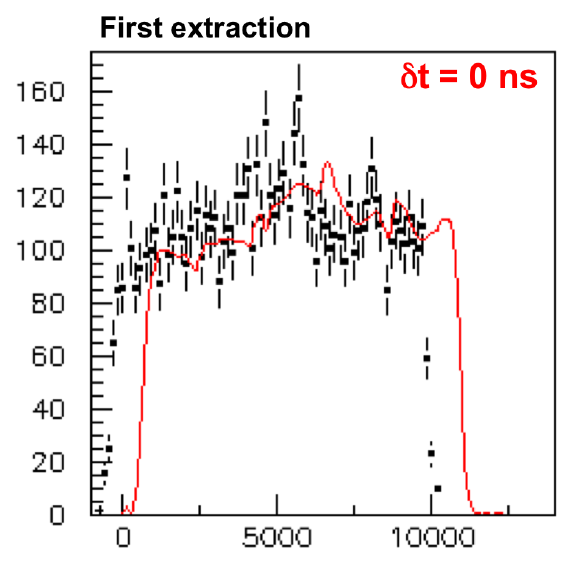OPERA neutrinos still faster than light
Posted by David Zaslavsky on — CommentsAmong this week’s big news in physics is that the OPERA experiment, which reported a detection of faster-than-light neutrinos back in September, has repeated their experiment and is still finding the same results. What they have changed this time is the width of the neutrino pulses, down to \(\SI{50}{ns}\).
 In the original measurement, neutrinos were generated in bunches more than \(\SI{3}{km}\) long, so that it took \(\SI{10.5}{\micro\second}\) for each bunch of neutrinos to pass through a detector. This spread is much larger than the \(\SI{60}{ns}\) or \(\SI{18}{m}\) discrepancy that the original OPERA paper reported. Some scientists were concerned that the neutrino bunches were getting distorted in flight, which could skew the apparent average time that it took for the neutrinos to travel the distance they did. I’m not sure how valid of a criticism this was, since if you look at the picture at the left, you can actually identify peaks and valleys of the experimentally detected shape of the neutrino bunch (the black dots, representing the rate at which neutrinos are detected as a function of time), which match up pretty well with corresponding features in the predicted shape (the red line) if you just shift them over by \(\SI{60}{ns}\) – this suggests that the distribution of neutrinos within the bunch did not change appreciably as it traveled. Still, it’s good that people raised that objection to make sure we were thinking about it.
In the original measurement, neutrinos were generated in bunches more than \(\SI{3}{km}\) long, so that it took \(\SI{10.5}{\micro\second}\) for each bunch of neutrinos to pass through a detector. This spread is much larger than the \(\SI{60}{ns}\) or \(\SI{18}{m}\) discrepancy that the original OPERA paper reported. Some scientists were concerned that the neutrino bunches were getting distorted in flight, which could skew the apparent average time that it took for the neutrinos to travel the distance they did. I’m not sure how valid of a criticism this was, since if you look at the picture at the left, you can actually identify peaks and valleys of the experimentally detected shape of the neutrino bunch (the black dots, representing the rate at which neutrinos are detected as a function of time), which match up pretty well with corresponding features in the predicted shape (the red line) if you just shift them over by \(\SI{60}{ns}\) – this suggests that the distribution of neutrinos within the bunch did not change appreciably as it traveled. Still, it’s good that people raised that objection to make sure we were thinking about it.
From what I’ve heard, the new measurements deal with this criticism by explicitly separating each bunch into individual \(\SI{50}{ns}\) pulses. This makes it possible to explicitly correlate different parts of the bunch as it is detected to their corresponding parts of the bunch as it is emitted. This pulse length is less than the \(\SI{60}{ns}\) offset that ostensibly indicates faster-than-light travel. Unfortunately the paper has not been made public on arXiv yet, so I haven’t seen exactly how their changes work, but it does seem that the objection about the bunches getting distorted definitely does not hold up given these new results.